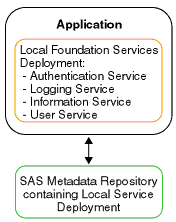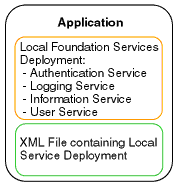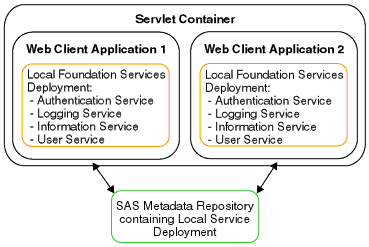SAS 9.1.3 Integration Technologies » Administrator's Guide
|
Foundation Services
Scenario: Stand-alone ApplicationA stand-alone application deploys services locally, uses the services, and terminates the services when they are no longer needed. If an application does not need to interact with any other applications, then it can be a stand-alone application with its own exclusive local service deployment. Services locally deployed by this application are not available to any other application; in addition, no remote services are available. Note: A foundation service-enabled application can be either a standard client application or a Web client application that runs in a servlet container. To deploy local services for its own exclusive use, the application:
When the application no longer needs the services or is ready to exit, it terminates the local Discovery Service; the local Discovery Service then destroys all locally instantiated services. Figures 1 and 2 show standalone applications that access their service deployments from a SAS Metadata Repository or XML file respectively. Figure 3 shows two standalone Web applications that access their service deployments from a SAS Metadata Repository and each deploy their own local services for their own exclusive use. Figure 1: Standalone Application accessing Local Deployment from a SAS Metadata Server Figure 2: Standalone Application accessing Local Deployment from an XML File  Figure 3: Two Standalone Web Applications accessing Local Deployments from a SAS Metadata Repository  |